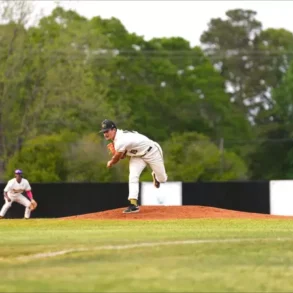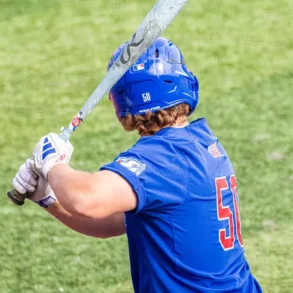
College baseball’s freshman class is always brimming with intrigue, but the 2025 group has already proven to be something different—a wave of instant impact talent that’s left fingerprints on the game’s highest levels.
From front-line starters to middle-of-the-order threats and shutdown relievers, first-year players have locked down critical roles on some of the top teams in the nation.
Today, we’re taking a closer look at 20 freshmen who have stood out so far in 2025. Players are listed alphabetically.
Smith Bailey, RHP, Arizona
Bailey arrived at Arizona off a decorated high school career, and the righthander has quickly carved out a key role on the Wildcats’ staff. Through his first nine appearances, Bailey has logged 41.2 innings with a 3.46 ERA, striking out 38 while walking 17. Equipped with a true four-pitch mix—fastball, slider, changeup and curveball—Bailey uses each offering more than 10% of the time and generates whiff rates north of 31% on all three offspeed pitches. His fastball, which averages 92.2 mph, anchors his arsenal, which has helped him emerge as one of the top freshman arms in the Big 12.
Myles Bailey, 1B, Florida State
Very few freshmen arrive as physically prepared for Power 4 baseball as Bailey, who walked onto the Seminoles’ campus at 6-foot-4 and 257 pounds. The first baseman has made an immediate impact, hitting .333 with nine home runs, seven doubles and 25 RBIs through his first 34 games. His sheer strength has translated cleanly to the college level, allowing him to post a .617 slugging percentage and a 1.061 OPS—both elite marks for a first-year player. Bailey’s early production and raw power make him a quick favorite to eventually grade out among the top power bats in the 2026 draft class when he’ll be eligible as a sophomore. There are swing-and-miss concerns—he’s struck out 51 times in 144 plate appearances—but the impact is very loud.
Cam Bagwell, RHP, UNC Wilmington
While Bagwell isn’t racking up gaudy strikeout totals yet, there’s still plenty to like about what the UNC Wilmington righthander is doing in his first season. The 6-foot-5, long-levered freshman has pitched to a 6-1 record and a 2.91 ERA across nine starts, leaning on a five-pitch mix that includes a low-90s fastball and a tight, efficient slider. His ability to command the zone (9 walks in 52.2 innings) and generate soft contact has fueled a 48% groundball rate, giving him a strong foundation as he continues to develop into a reliable weekend starter.
Tyler Bell, SS, Kentucky
Bell entered college baseball with a national spotlight on him after being selected in the second round by the Rays, and he has more than lived up to the hype. The shortstop has thrived in a premium defensive role and produced at the plate, hitting .321 with five home runs, 13 doubles and 31 RBIs across 34 games. Bell reached base in each of his first 27 career games, flashing the bat speed and strength that made him such a coveted prospect out of high school. He’s shown an advanced ability to drive the ball to all fields, giving Kentucky a dynamic presence at a critical position. He’ll be re-eligible for the draft again next year and has first-round potential.
Levi Clark, DH, Tennessee
Clark has quickly emerged as one of the most versatile and dangerous freshmen in the SEC. The Tennessee slugger has already logged time at first base, catcher and left field while primarily serving as the Volunteers’ designated hitter, showcasing defensive flexibility and an advanced approach at the plate. Clark’s offensive production jumps off the page: a .333 batting average, seven home runs, a .710 slugging percentage and a 1.200 OPS across his first 29 games. His ability to create impact stems from a powerful load transfer that allows him to consistently drive the baseball with authority. Tennessee’s coaching staff has been bullish on Clark’s future, and it’s clear why.
Derek Curiel, OF, LSU
There’s a captivating ease to the way Curiel plays the game. LSU’s freshman outfielder operates with maturity and polish on both sides of the ball, showing off premium athleticism with diving plays and advanced route running in left field. He’ll one day play center. At the plate, Curiel has walked more than he’s struck out while showcasing exceptional swing decisions and a sweet lefthanded stroke capable of spraying the ball to all fields. Through 38 games, he’s batting .362 with a .494 on-base percentage and 1.041 OPS—numbers that reflect his elite feel for the barrel. Physically, the 6-foot-2, 182-pounder has started to fill out since leaving high school, but still offers considerable projection. Already a standout performer, Curiel figures to be one of the premier players to watch in the 2026 draft class.
Tague Davis, 1B, Louisville
Davis arrived at Louisville as a two-way player but has leaned almost exclusively into his bat since joining the program—and the early returns have been impressive. Through his first 34 games, the freshman first baseman is hitting .304 with 14 home runs, 36 RBIs, and a 1.134 OPS. Although Davis entered college with a longer swing, it hasn’t been a major issue; he’s posted a manageable 20 walks against 32 strikeouts so far. The son of former big leaguer Ben Davis, Tague offers the kind of physicality, natural bat speed and presently-plus power to develop into a strong first baseman at the next level.
Casan Evans, RHP, LSU
Evans arrived at LSU as a highly-touted two-way player out of Houston’s St. Pius X High School. He has since focused exclusively on pitching, blososming into one of the Tigers’ most electric young arms. Working out of the bullpen, the righthander has flashed premium stuff with a fastball that’s touched 97 mph and a pair of devastating secondary offerings. His changeup has generated a 56% whiff rate, and his slider isn’t far behind at 51%, giving him two genuine out pitches to pair with velocity. Evans’ funky delivery adds deception to an already overwhelming arsenal, helping him emerge as a bullpen weapon for one of the deepest staffs in college baseball.
Chase Fralick, C, Auburn
Pressed into catching duties earlier than expected, Fralick has more than held his own as Auburn’s primary backstop. With junior Ike Irish limited mostly to DH duties due to injury, Fralick has stepped up both behind the plate and in the batter’s box. He’s impressed defensively with a strong, accurate arm, showing the ability to control the running game. Offensively, he’s exceeded expectations, slashing .351/.408/.489 across 35 games with 30 RBIs. Fralick’s advanced bat-to-ball skills have made him a key part of Auburn’s lineup and a player who looks poised to be a cornerstone behind the plate for years to come.
Noah Franco, OF/LHP, TCU
Franco wasted no time stepping into a two-way role at TCU and has already flashed the immense upside that made him a coveted recruit. While his overall pitching numbers remain a work in progress, Franco has shown electric stuff on the mound, running his fastball up to 97 mph and generating a 45% whiff rate with a sharp slider. At the plate, he’s been particularly impactful, hitting .313 with seven home runs, 10 doubles, 26 RBIs and a .992 OPS across his first 35 games. Franco combines an explosive lefthanded swing with a highly-projectable frame, giving scouts plenty to dream on as he continues to develop both ways.
Jake Hanley, 1B, TCU
Hanley brought impressive strength and raw power with him to Indiana and has quickly made good on that promise. After a successful two-way career in high school, Hanley has focused solely on hitting at the college level—and the results have been immediate. The freshman first baseman is slashing .352/.451/.545 through 37 games, with seven home runs, seven doubles and 33 RBIs. His physicality and barrel control make him a natural fit for the heart of the order, and he profiles as a player capable of doing serious damage throughout his college career and beyond.
Alex Hernandez, 2B, Georgia Tech
Hernandez has found a home at second base for Georgia Tech after seeing some time at multiple spots early on in his college career, including the outfield, first base and the mound. Since settling into a full-time role at second, he’s emerged as a staple in a lineup pushing toward NCAA Tournament hosting status. Hernandez’s excellent bat speed and raw strength have fueled a breakout season, as he’s hitting .348 with 10 home runs, 45 RBIs and a 1.081 OPS through 37 games. He’s also quieted some early swing-and-miss concerns, posting a near one-to-one strikeout-to-walk ratio (28 strikeouts to 27 walks). With his offensive polish and rising profile, Hernandez is firmly on a meteoric trajectory. He’s eligible for next year’s draft.
Terrence Kiel II, OF, Texas A&M
Kiel has spent most of his freshman season stationed in right field while first-round talent Jace LaViolette holds down center, but make no mistake: Kiel is the best defensive outfielder on Texas A&M’s roster and projects as a future double-plus center fielder. His glove and range have been elite already, and he’s more than held his own at the plate, hitting .349 with eight doubles, 22 RBIs and an .863 OPS across 36 games. Kiel has emerged as a huge piece of the Aggies’ surge back into postseason contention and looks like a foundational player for the program’s future outfields.
Aidan King, RHP, Florida
King’s progression since arriving at Florida has been propelled by rocket fuel. After showing a low-90s fastball in high school and throughout his first fall in Gainesville, he made an earlier-than-expected velocity jump this spring, running his fastball up to 97 mph while showing advanced feel for a sharp slider and fading changeup. He’s also begun mixing in a splitter that evaluators believe has the ingredients to develop into at least an average fourth offering. Beyond the pure stuff, arm speed and athleticism, King stands out for his bulldog mentality by attacking hitters in the zone with confidence and poise. Through 40.1 innings, he’s pitched to a 2.68 ERA with 44 strikeouts against just 12 walks, establishing himself as Florida’s most effective arm during an injury-riddled season. He profiles as a future Friday night ace and early-round pick in the 2027 draft.
Brendan Lawson, 1B/2B, Florida
Florida beat the draft to get the Canadian native Lawson to campus, and it didn’t take long for him to prove he belonged in the lineup. After an impressive fall, the Gators shifted Lawson from third base to first to accommodate his bat. While his defense remains somewhat of a work in progress on the right side of the infield, Lawson’s offensive impact has been undeniable: a .313 average with eight home runs, 41 RBIs and a .992 OPS through his first 38 games. Lawson utilizes a uniquely-high handset, but it doesn’t prevent him from consistently being on time to the baseball. He’s already shown above-average pull-side power and the barrel control to drive the ball to all fields. Though he’s playing first base for now, Lawson profiles as Florida’s third baseman of the future and is building a case to be a high-end prospect for the 2027 draft.
Jack Ohman, RHP, Yale
Ohman, the son of longtime MLB veteran Will Ohman, has erupted onto the college baseball scene with one of the most dominant seasons in recent history. The Yale righty is pitching to a microscopic 0.19 ERA over 47.1 innings with 55 strikeouts, 11 walks and just 25 hits allowed. Armed with a lively mid-90s fastball and a two-plane slider that has produced a 55% whiff rate, Ohman has made hitters look overmatched all spring. In today’s transfer portal era, it’s fair to wonder if Ohman might eventually become a hot commodity, but for now, Yale has a true ace leading its staff and rewriting the record books.
Sawyer Strosnider, OF, TCU
Baseball America’s Midseason Freshman of the Year, Strosnider wasted no time in flashing nearly every tool in his bag. The TCU right fielder has quickly established himself as one of the most complete young hitters in the country, blending bat speed, barrel accuracy and athleticism to spray hits to all fields with authority. Through his first 36 games, Strosnider is slashing .393/.456/.714 with eight home runs, 42 RBIs and a 1.170 OPS—a staggering line for any player, let alone a freshman. With a dynamic offensive profile and early production that rivals some of the nation’s best, Strosnider looks like a future star in Fort Worth and the draft.
Dylan Volantis, LHP, Texas
Volantis has seized his opportunity in Austin, stepping into the closer role after Ruger Riojas transitioned to the rotation, and he’s quickly made himself one of the premier bullpen arms in college baseball. The Texas lefthander has posted a 1.08 ERA across 33.1 innings, striking out 44 while allowing just 19 hits. His curveball—a clearly plus pitch—has toyed with college hitters all spring, overwhelming them with sharp bite and late depth that’s well above what most players his age can offer. With tons of physical projection still remaining, Volantis already looks like a future star and one of the most exciting arms to watch in the country.
Dax Whitney, RHP, Oregon State
There’s something captivating about watching Whitney take the mound. The Oregon State righthander moves with fluid, athletic mechanics and commands an arsenal that already ranks among the best in his class. Whitney’s fastball consistently generates over 20 inches of induced vertical break without him needing to over throw, a testament to his natural feel for spin and arm speed. He complements it with a sharp, high-spin slider and a true 12-6 hammer curveball that might be his best secondary offering. Through nine starts, Whitney owns a 2.88 ERA with 60 strikeouts in 40.2 innings. He’s performing like a Freshman All-American candidate and positioning himself as a premium 2027 draft prospect.
Carson Wiggins, RHP, Arkansas
Wiggins is already making waves as one of the most electric arms in college baseball. After touching 99 mph in high school, the Arkansas righthander has climbed even higher this spring, reaching 102 mph just weeks into his collegiate career. Wiggins has paired his elite velocity with dominant results, posting a 2.25 ERA with 17 strikeouts over 12 innings while holding opponents to just five hits. Hitters have struggled to square him up, though occasional lapses in control remain part of his development curve. Still, Wiggins looks every bit like the next freakishly talented arm to emerge from the Arkansas pipeline—and a potential future star at the next level.
This post was originally published on this site be sure to check out more of their content.





